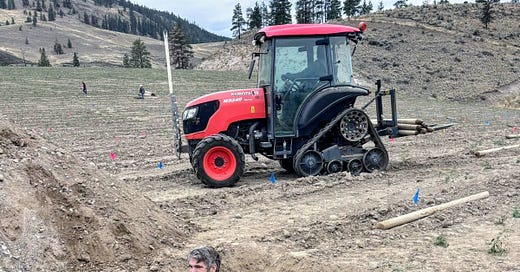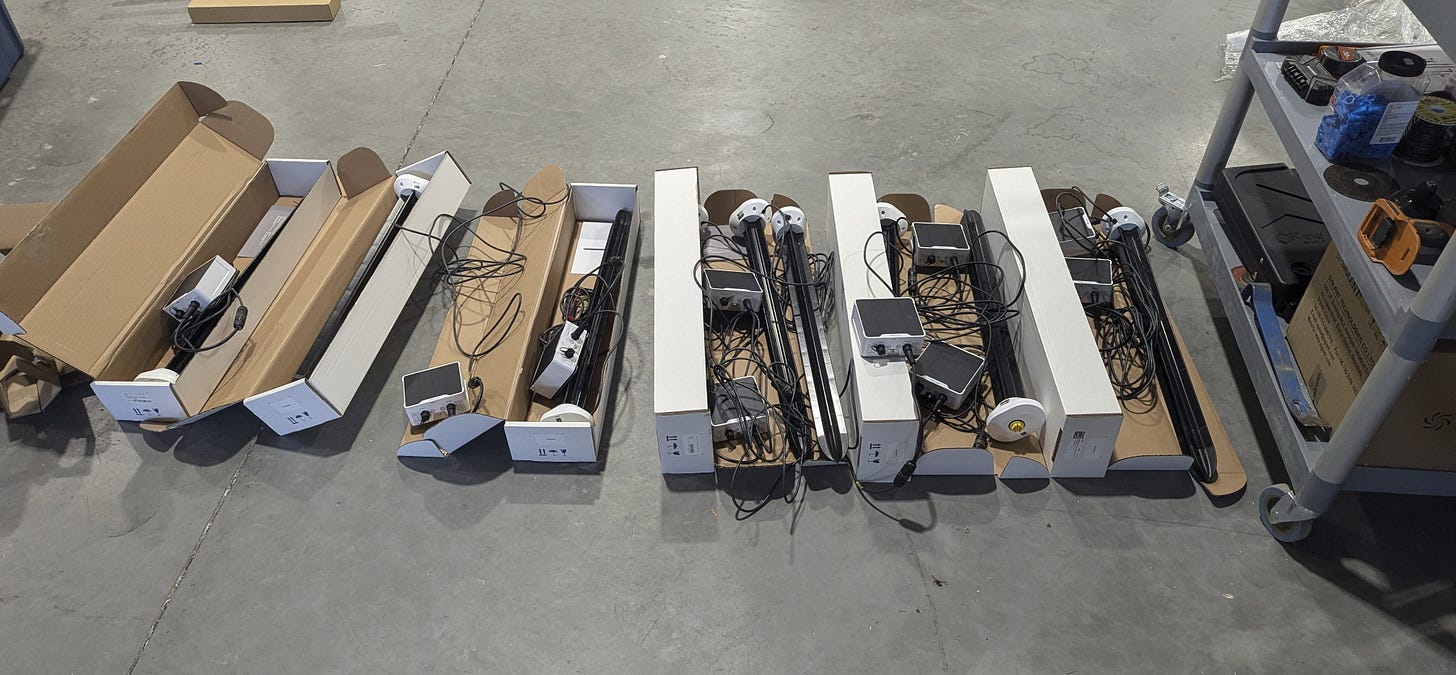“A great Pinot Noir should make you feel as though Grace Kelly just walked in the room.”
I don’t think I’ve ever seen a bad Grace Kelly movie. Or a movie the Princess of Monaco was bad in? Two personal favorites are High Society (her last movie) and To Catch a Thief… if you haven’t seen either, highly recommend!
And while we’re on the off topic of movies, I’ve finally gotten around to watching Amadeus and oh my! What an absolutely splendid movie!
Of course now with our second child… we’ll have it finished in a neat two weeks. If we’re lucky.
A couple quick notes.
I’ll be in Napa for a couple of days for an event at Stag’s Leap so I’m very much looking forward to that. Might have some interesting things to report back (stay tuned).
Oh, and before moving onto the meat and potatoes a reminder if you have a BC farm and are a (potential) client - time to get trellising and post orders in!
Lastly, the Southern Interior Hort Show has opened for registration. It sounds like it’ll be even bigger and better than last year.
Register here.
Onwards!
Grant Funding Details
Enhanced Replant Program (ERP) Funding
If you work in the BC wine industry, you’re probably aware that there is new funding available to aid with replanting vineyards.
To be blunt, the program is a bit of a mess and there are quite a few things that don’t make much sense. That’s just the way it is and there are hoops to jump through to access the funding.
Key Dates:
Applications Open: October 29, 2024
Submissions Open: November 26, 2024, 9 AM
Applications Close: December 3, 2024, 4 PM
The basic eligibility requires being in good standing with the BC Wine Grape Council (all levies paid) and having a soil nutrient test.
The actual requirements are more complicated with a scoring system and restrictions on which nurseries can be purchased from. The concerns are over plant material and the short answer is that they need to be CCGN certified, or from Washington or Oregon, and maybe it’s okay from California if they have a good testing protocol. France is not yet certified and might not be until 2025 (or not at all).
We will be producing a short guide to help with applications which will be available shortly. We will probably send it out here, but if interested contact addison@vintality.com to get notified when we send it out.
You can find program details here.
Latest BCCAF Funding Closing Thursday (14th)
Just a quite reminder that the latest round of BCCAF funding for cover cropping and nitrogen management is closing November 14th (Thursday).
This is very easy funding to access that can cover $30,000 in either or both categories.
Find out more here or contact us for assistance.
Grower 3-2-1
I was asked to write a short piece for the BCGA’s monthly column “Grower 3-2-1”. If you’ve been following me for a while, you may have figured out short is not my thing.
This is what I prepared for their October issue and I wanted to share it here:
3 Things We’re Doing
Even without a harvest at most farms, it’s a busy time of year. There’s lots going on – not only are we all blowing out irrigation and repairing trellising; now’s a great time to take soil samples, do viral surveys due to fall colours and being making pruning decisions for 2025. I want to touch on a few other key activities.
One piece we are working on right now, before irrigation blow out, is refilling the soil reservoir. The reasons are plenty and the impact significant – especially given how dry a fall we’ve had.
First, as the vine moves resources to the root this requires adequate moisture both in the leaves, for transpiration, and in the soil, to allow nutrient uptake. All carbohydrates being produced now are being stored for next season and will be relied on by the vine until it has about 6 nodes (more on that at #2). And a wet soil is more resistant to cold damage and this will better protect the roots through a cold event.
The water you’re refilling now won’t “last” until next season, even a 24 hour set is insignificant in the scheme of things. Instead, it is about protecting and supporting the vine now and for the next few months. It may very well be necessary to do a big refill early in the spring again!
For context, these sets regularly are 24 hours or longer. And if you have a soil moisture sensor you can compare your current moisture levels vs. in Feb/Mar to see what your refill point is and fill to that. You can see below of how quickly even large sets can draw down (this is over five days). You can also see in the soil moisture graph below how little moisture the deeper, 60cm, layer receives:
This is also a friendly reminder you should have been irrigating regularly post-veraison so vines should not be dry and then receiving a hit. At the post-veraison stage irrigation has no effect on berry water status (unless you have serious berry shrivel) and we want to ease off the water stress we’ve put vines in preveraison.
We’re also working on post-harvest fertilisation. The reason for doing so is the same as above – allowing the vines to store as many resources as possible. At this stage, we are entering a period of high root growth as carbohydrates are moved from above ground to below.
This is a more controversial topic without clear answers. Even following the publication of this piece, I survived a number of growers (including at large operations) and the thinking around this topic was uncertain. Even if you are worried about preventing growth or slowing dormancy, asking basic questions about this could occur and what ranges should be was met with uncertainty.
I wonder if our practices around post-harvest fertilisation are because of well established best practices or group-think? I don’t know.With an adequate carbohydrate reserve in the spring, we will see better bud break, consistent shoot emergence and growth, and healthy canopy size. A study that removed all leaves post-harvest found a 21% yield reduction next season and a 50% reduction after! Our vines, as long as they have leaves, are still actively gathering and shipping resources below ground.
Unlike with irrigation, what fertilizer to apply is less certain. In short, in regions with a colder autumn (like ours) nitrogen applications can compete with carb storage, never mind issues with applied ammonium at this stage. And given most soils in the Okanagan have high potassium, this application can be unnecessary. This leaves the more common application of phosphorus (if needed), calcium, and boron.
In an organic contexts, this can be a time to apply a fall compost, particularly targeting weaker areas (even though this will not be immediately available). Much like with a conventional approach, the precise supports will be determined by known nutritional weaknesses.
Ultimately, like with irrigation, the goal is to encourage root growth and carb storage. If you dig a soil pit at this time, you should see roots have shed their bark to allow this growth - a rare site surprisingly few have seen!
The last piece is to prepare for winter. We need to assume that we will be hit with similar cold events and do what we can to prepare. One piece we are working on is a geotextile trial with four participating wineries to see what alternative textiles and coverage methods could provide protection to our trellising systems. Unfortunately, we cannot lower our fruit zone due to our summer heat (if anything it needs to be raised) necessitating alternative methods of handling the cold than you see back east or in the midwest. We’ll be excited to report back after this winter’s data.
At this stage some clients are hilling up and laying down, ideally with dual or U-stakes to minimize vine damage. Other clients are only now cutting down trunks due to fears of disease in the spring and summer which is at high risk given the size of wound and sap flow. But the tradeoff is risk to shoots (and available labour).
A reminder that it is the decreasing day length and cooler temperatures that trigger dormancy. Positively, we should be better prepared for the cold as the plants are entering dormancy without having spent resources on the grapes. We’ve certainly seen earlier lignification this year. This will again be aided by the vine storing more reserves in the roots (again helped by a lack of fruit sinks).
2 Things I’ve Learned
My biggest learning this season was a better understanding of a vine’s vascular system. Given the clear signs of phloem and xylem damage (as well as disease) we saw when cutting into trunks this spring, I believed it was inevitable we would have some degree of vine collapse. My thinking was that given the degree of vascular damage from the cold plus historically poor pruning and now rampant disease, the summer heat hit we would be unable to keep up.
And we did hit very high VPD numbers (a measure of atmospheric pressure on the plant, pulling out water from the leaves). As in internationally high numbers down in Oliver and Osoyoos. And while this likely will cause some degree of damage, we did not see any major collapse. Our systems continue to be more resilient than I expected! I must give credit to two colleagues who were very skeptical collapse even exists. While there may be collapse due to viral infection, like leafroll in Lodi a few years ago, I must confess my colleagues were correct and we were not threatened by that form of collapse.Everything old is new again. I won’t say I’ve completely changed my mind, but I am beginning to wonder if all the Old Heads who prefer overheard irrigation are right. We can’t go back, at any scale, to overhead given how efficient drip is but on many of our soils overhead might be better. We’ve anecdotally seen better mildew resistance and root exploration, as well as some impressive yields with strong fruit quality. It’s interesting – there’s very little research comparing overhead vs. drip in terms of vine performance metrics!
(I also don’t think it’s worth it to switch from overhead to drip until you replant, I’m not sure I’ve ever seen a vineyard recover to previous yields from this switch).
1 Thing I’m Thinking About
The first thing that pops into my head is all the people facing challenges with job losses at almost every company, never mind the Growers bankruptcy. I feel immensely for the challenges these colleagues of ours, in particular, are facing.
But I want to end on a positive note and recommend a book I haven’t been able to stop thinking about. It’s a classic, John Graves’ “Goodbye to a River”.
It’s a true story, his retelling of a 3-week canoe trip down the Brazos River in November, 1960. He took the trip because thirteen dams were about to be built on this historic river, forever damming and destroying this river that had carried thousands of years of history and people. It’s the story of a fragile beauty in the face of the bulldozing of progress.
“But if you are built like me, neither the certainty of change, nor the need for it, nor any wry philosophy will keep you from feeling a certain enraged awe when you hear that a river that you’ve known always, and that all men of that place have known always back into the red dawn of men, will shortly not exist.”
You can read in as much of our current predicament as you’d like. But the surprise is that, because of this book, because of this canoe trip and the stories it told, only three dams were built.
There are some victories.









